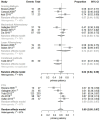Vessel Preparation in Infrapopliteal Arterial Disease: A Systematic Review and Meta-Analysis
- PMID: 36062761
- PMCID: PMC10938478
- DOI: 10.1177/15266028221120752
Vessel Preparation in Infrapopliteal Arterial Disease: A Systematic Review and Meta-Analysis
Abstract
Purpose: Infrapopliteal lesions are generally complex to treat due to small vessel diameter, long lesion length, multilevel disease, and severe calcification. Therefore, different vessel preparation devices have been developed to contribute to better peri- and postprocedural outcomes. This systematic review aims to compare different vessel preparation techniques prior to plain old balloon angioplasty (POBA) or drug-coated balloon (DCB) angioplasty with POBA or DCB alone in infrapopliteal arterial disease.
Methods: Medline, EMBASE, and Cochrane databases were searched for studies published between 2000 and 2022 assessing the value of adjunctive vessel preparation in infrapopliteal arterial disease. The primary outcomes were 12-month primary patency and limb salvage.
Results: A total of 1685 patients with 1913 lesions were included in 11 POBA studies. Methodological quality was assessed as poor to moderate in these studies. Only 2 studies with 144 patients assessed vessel preparation in conjunction with DCB angioplasty. These randomized trials were assessed as high quality and found no significant benefit of adjunctive atherectomy to DCB angioplasty. The pooled Kaplan-Meier estimates of 12-month primary patency and limb salvage in the POBA studies were 67.8% and 80.9% for POBA, 62.1% and 86.4% for scoring balloons, 67.9% and 79.6% for mechanical atherectomy (MA), and 79.7% and 82.6% for laser atherectomy, respectively. Within the pooled data only scoring balloons and MA demonstrated significantly improved 12-month limb salvage compared to POBA.
Conclusions: Different forms of adjunctive vessel preparation demonstrate similar 12-month outcomes compared to POBA and DCB angioplasty alone in infrapopliteal disease, with the exception of improved 12-month limb salvage in scoring balloons and MA. However, since the included studies were heterogeneous and assessed as poor to moderate methodological quality, selection bias may have played an important role. Main conclusion is that this systematic review found no additional value of standard use of vessel preparation.
Clinical impact: Infrapopliteal arterial disease is associated with chronic limb-threatening ischemia (CLTI) and generally complex to treat due to small vessel diameter, long lesion length, multilevel disease and severe calcification. A wide range of vessel preparation devices have been developed to contribute to improved peri- and postprocedural outcomes in these complex lesions. This systematic review aims to compare different vessel preparation techniques prior to plain old balloon angioplasty (POBA) or drug coated balloon (DCB) angioplasty with POBA or DCB angioplasty alone in infrapopliteal arterial disease. Different forms of adjunctive vessel preparation demonstrate similar 12-month outcomes compared to POBA and DCB angioplasty alone in infrapopliteal disease, with the exception of improved 12-month limb salvage in scoring balloons and mechanical atherectomy (MA). However, since the included studies were heterogeneous and assessed as poor to moderate methodological quality, selection bias may have played an important role. Main conclusion is that this systematic review found no additional value of standard use of vessel preparation.
Keywords: atherectomy; below the knee; infrapopliteal; scoring balloons; tibial; vessel preparation.
Conflict of interest statement
Declaration of Conflicting InterestsThe author(s) declared no potential conflicts of interest with respect to the research, authorship, and/or publication of this article.
Figures





References
-
- Graziani L, Silvestro A, Bertone V, et al.. Vascular involvement in diabetic subjects with ischemic foot ulcer: a new morphologic categorization of disease severity. Eur J Vasc Endovasc Surg. 2007;33:453–460. - PubMed
-
- Saeedi P, Petersohn I, Salpea P, et al.. Global and regional diabetes prevalence estimates for 2019 and projections for 2030 and 2045: results from the International Diabetes Federation Diabetes Atlas, 9th edition. Diabetes Res Clin Pract. 2019;157:107843. - PubMed
-
- Abu Dabrh AM, Steffen MW, Undavalli C, et al.. The natural history of untreated severe or critical limb ischemia. J Vasc Surg. 2015;62:1642–1651.e3. - PubMed
Publication types
MeSH terms
Substances
LinkOut - more resources
Full Text Sources
Medical

